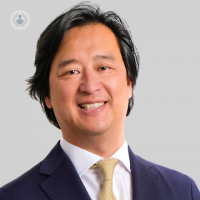Are glaucoma drops safe? Your FAQs answered
Written in association with:Eye drops are one of several methods for controlling glaucoma. Professor Kin Sheng Lim is an internationally renowned ophthalmologist in London and an expert in the diagnosis and management of glaucoma. Learn from him about what these eye drops contain, if they are safe, possible side-effects and more.

How can glaucoma be controlled?
Glaucoma consists of high pressure in the eye and any treatment prescribed has the objective of lowering this pressure. Non-invasive laser procedures such as SLT (selective laser trabeculoplasty) are usually given as the first line of treatment. However, if you have not responded to the SLT treatment or your type of glaucoma is not suitable for SLT laser surgery, your doctor will usually recommend eye drops to lower the pressure.
What do eye drops for glaucoma contain?
Most eye drops for glaucoma will have one or two ingredients . In most cases, drops will contain a preservative to keep the content sterile for the duration of the usage (which is usually about one month). The active ingredient for your glaucoma drops differs depending on the type of glaucoma.
There are, in general, four main classes of glaucoma medication and the one people are prescribed depends on:
- The specific objective of the drops.
- The different areas of the eye where the medication acts on.
How do eye drops work?
Some of the drops lower eye pressure by reducing the amount of aqueous inside the eye, which is a thin, watery fluid that the eye produces . Other drops will increase the drainage of the aqueous out of the eye. Ultimately, either of these actions will lead to the eye pressure being lowered.
Are drops for glaucoma safe?
Eye drops for glaucoma are, overall, very safe. Some of the drops could have systemic side effects for patients with specific conditions but your doctor will have taken your medical history into account when prescribing the appropriate glaucoma treatment for you.
All four classes of glaucoma drops that are commonly used today have been around for over 20 years. Not only have we (medical specialists) extensively studied them, but we have also had many years of practical experience with the drops.
What are the main side effects of glaucoma drops?
Most side effects tend to be a local side effect related to the eye, causing it to become red or uncomfortable. Usually, this type of side effect is caused by the active ingredient of the glaucoma drops. There are very small sub-sets of patients who develop toxicity or discomfort from the preservative used in the glaucoma drops. However, I must emphasize that preservative toxicity is uncommon and most side effects are actually caused by the glaucoma drop active ingredient itself.
Some glaucoma drops are generally not recommended to patients with asthma or certain heart conditions. This is because drops can cause breathing problems or heart rate problems in these patients.
Is there an alternative to eye drops for glaucoma?
In general, most ophthalmologists would consider SLT laser as an alternative to eye drops for treating glaucoma (provided your type of glaucoma is suitable for SLT laser). However, if you develop toxicity or serious side effects from multiple glaucoma drops, the next step in controlling eye pressure will be a more invasive glaucoma surgery. The type of surgery will depend on the type of glaucoma and the severity of your condition.
Learn how Professor Sheng Lim’s leading medical expertise can help you care for your eyes – visit his profile.


